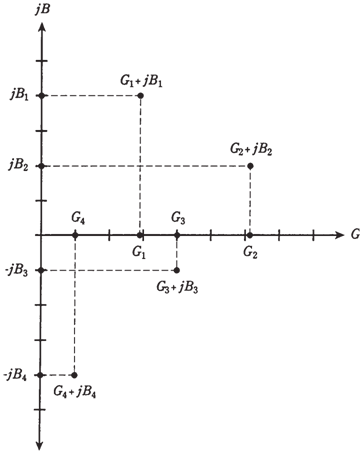GB plane:
Admittance is depicted on the plane which looks just like complex impedance (RX) plane. Actually, it is a half plane, as there is no such thing as negative conductance. (You can't have something which conducts worse than not at all.) Conductance is plotted along horizontal, or G, axis on the coordinate half plane, and susceptance is plotted along B axis. The plane is shown in the Figure given below with several points plotted on it.
Although GB plane looks identical superficially to the RX plane, the difference is great! The GB plane is blown inside out from the RX plane, as if you had jumped into the black hole and undergone the spatial transmutation, inwards out and outwards in, turning zero into infinity and vice-versa of it. Mathematicians find this kind of stuff easy.
The center of the GB plane represents the point at which there is no conduction of any kind whatsoever, either for direct current or for the alternating current. In RX plane, origin represents the perfect short circuit; in GB plane it corresponds to an ideal open circuit.
The open circuit in RX plane is way out beyond the sight, infinitely far away from origin. In GB plane, it is the short circuit which is out of view.

Figure-- Some points in the GB plane, and their components on G and B axes.
Formula for conductance
As we move out towards right ("east") along G, or conductance, axis of GB plane, the conductance improves, and current becomes greater, but only for direct current. The formula for G can be simply given as
G =1/R
where R is resistance in ohms and G is conductance in siemens, sometimes called as mhos.
Formula for capacitive susceptance
It will not hurt to review the formulas for susceptance again. They can get a little bit confusing, especially after working with reactance.
When you move upwards along the jB axis from origin, you have ever increasing capacitive susceptance. The formula for this quantity, BC, is given below
BC = 6.28fL siemens
where f is in Hertz and C is in given farads. The value of B is in siemens. On the other hand, you can use frequency values in megahertz and the capacitances in microfarads. The complex value is given by jB = j(6.28fC).
Moving upwards along jB axis indicates increasing the capacitance values.
Formula for inductive susceptance
When you go down along the jB axis from origin, you encounter increasingly negative susceptance. This is inductive susceptance; formula for it is
BL = 1/(6.28fL) siemens
here f is in Hertz and L is in henrys. On the other hand, f can be expressed in megahertz, and L can be expressed in microhenrys. The complex value given is jB = -j(1/(6.28fL). Moving downwards along jB axis indicates decreasing values of the inductance.